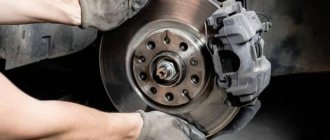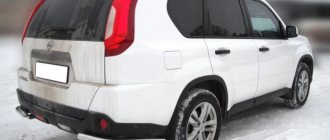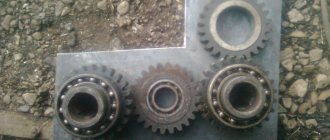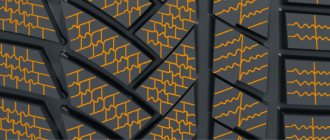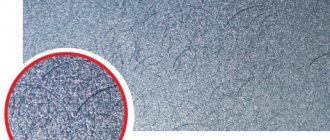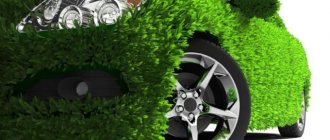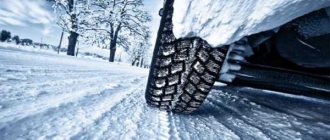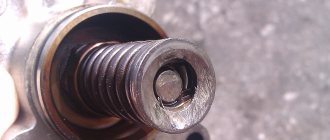The principle of operation of the spike
When the car moves, the spike digs into the coating, even into fairly strong ice. This leads to improved road grip. As a result, the tire can grip slippery surfaces more effectively, avoiding slipping. To avoid the problem of a stud getting into the grooves from the previous one, studding is carried out strictly according to a certain pattern. The next spike clings to a different place, which is especially important in a situation where the car has skidded on ice.
The stud must sit firmly in the tread; this is a prerequisite for good grip. The attachment point is made of a stiffer rubber compound. This way it is possible to achieve optimal performance of studded tires.
How did you use it?
At first, the stud bodies were made of steel and could not boast of outstanding characteristics. A standard stud of the 60s had a diameter of 9 mm, a height of 14 mm and a weight of 3 g. Moreover, according to official research, the wear of the road surface from the use of such studs on one car was approximately 150 grams per kilometer! As soon as the struggle to preserve the road surface began and the mass of spikes was limited, more advanced designs began to appear. Compared to its prototype, the spike of the 90s had much more acceptable parameters (diameter/height/weight: 8/11/1.1) and its impact on the road was considered much more gentle. Recently, the use of steel has been abandoned in favor of aluminum alloys, which has made it possible to further reduce the weight of the stud, while maintaining the strength of the body at the same level.
Metal-plastic spikes turned out to be ineffective, although high hopes were placed on them in the 70-80s. Still, the weight of the spike did not exceed 0.7 grams, and sufficient mechanical strength was ensured. It seemed that a new technological breakthrough had been made, but real tests showed that under particularly harsh conditions (sharp temperature changes, high speed loads) the plastic stud wears out prematurely. And all because plastic and metal have different coefficients of thermal expansion. It is possible that cermets will have the last word, but today the most advanced design is a spike made of alloyed aluminum. It is quite light (approximately 0.9 grams), has high strength and anti-corrosion resistance.
Types of studs in winter tires - what shapes they come in
In practice, many different types of winter tire studs can be used. First of all, it is worth dividing them by material.
- Steel. The simplest variety. They came first. They provide good grip and wear out slowly. They have a large mass and are prohibited in many countries. They can rust, which negatively affects the service life of the tire.
- Aluminum. A more modern option. Lightweight, no corrosion problems. The disadvantage is the tendency to abrasion.
- Plastic. Nowadays they are rarely used. They were created in connection with the emergence of restrictions on the mass of the stud, but in the end it turned out that their service life was not long enough.
- Dual-alloy. They have a hard core and a soft metal body. Tungsten is usually used as the core, and aluminum is used to make the body.
The most widespread now are two-alloy studs.
The shape of the spikes is also important. According to manufacturers, this allows you to achieve the best technical performance. Let's look at what kinds of spikes there are according to this parameter.
- Round. A budget option. According to statistics, the most common. They are considered to have the worst grip on the tire and provide insufficient grip.
- Tetrahedral. They have clearly defined four edges. This shape makes it possible to reliably “bite” into the ice. Particularly good on turns. The disadvantage is that it wears out quickly and is prone to breaking off.
- Oval. It is considered a type of round thorn. The contact area with the road is higher here, which reduces the risk of skidding.
- Diamond. This shape is used on Gislaved tires. It is distinguished by the presence of five sides. They quickly grind down and the tenon becomes oval.
- Diamond-hexagonal. Patented Nokian spike. They have a fairly sharp edge that cuts into the coating well. The presence of six sides makes it possible to maintain efficiency in any position of the wheels. It has a kind of cushion that ensures that the stud moves into the tread block when driving on asphalt.
- Heptagonal. Manufactured by Pirelli. Provides good grip when starting to move.
- Three-beam. Three beams work well on ice. But they chip easily on asphalt.
- Trapezoid. Fits on Goodyear tires. The rounded trapezoidal shape allows you to maintain good directional stability. Sits securely in the nest.
- Cross-shaped. The spine is divided into four segments. The disadvantage is the quickly grindable edges.
- Triangular. It is rare, but according to the manufacturer it has good driving characteristics.
The effectiveness of studs of different shapes differs only on completely new tires, and also strictly on ice. For use under normal conditions with different types of surfaces and long-term use of tires, you can easily get by with a simple round stud.
Spikes against ice
Despite the use of all-season and winter tires, anti-skid studs are still widely used on both passenger cars and trucks. There are a number of reasons for their continued popularity.
From carts to cars
The need for anti-skid studs arose a long time ago, when pneumatic tires did not yet exist, but only horse-drawn carts. So that horse-drawn vehicles could move in muddy roads or on icy roads, spikes and various metal pins were inserted into the wheel rims. With the advent of automobiles, the need for spikes disappeared for some time. However, it arose again when cars began to move at relatively high speeds in all seasons and the need arose to safely overcome snow and ice drifts.
As specialists from St. Petersburg told us, in the thirties of the last century, studs appeared on the tires of sports motorcycles and cars, similar to modern ones, used for their intended purpose - to increase the grip of wheels on ice. The spikes were fastened with nuts or screws, stitching right through the tire. In the fifties, all-metal studs began to appear in Scandinavian countries, pressed into the tread of the tire tread. In 1959, a stud design was developed in Finland, consisting of two parts: a steel body and a carbide cylindrical insert. This is the design that is still used today.
The stud overhang is usually called the height of its protrusion above the tread surface in a studded tire.
During operation, an interesting fact emerged: the wear of the hard alloy began to correspond with the wear of the tire rubber itself, that is, the wear rate of the tire rubber and the wear rate of the carbide insert turned out to be close. Thus, the thickness of the rubber coating and the “overhang” of the carbide insert decrease over time by approximately the same amount. Thanks to this effect, the stud sticks out for quite a long time and performs its function, and does not grind down to the level of the tire. And this gave manufacturers the idea that such a composition - a steel body with a carbide insert - would help solve the problem of movement in winter.
Tenon design
The stud body can be made of structural steels, light alloys based on aluminum, plastics or other materials. In recent years, aluminum or aluminum alloys have often been used for the body, since they are lighter than steel, and the lower the mass of the stud, the less wear on the road. In addition, there is no need to cover aluminum with protective and decorative coatings, because it does not rust. But in Russian conditions, when the road is watered with potassium, sodium and other salts, an alkaline reaction is often created. Therefore, aluminum is not always good, since it corrodes in an alkaline environment and the wear of the aluminum body can be very rapid and aggressive.
A cone-shaped carbide insert is inserted into the hole in the tenon body. All over the world this element is manufactured according to the same principle. This is a classic technology of powder metallurgy, when a mixture of tungsten carbide with various additives is mixed and cobalt, nickel, and iron can be used as a binder. Then this entire mixture is mixed, pressed, sintered, after which an insert is made from it using automatic presses.
The body of the tenon can be either stamped or turned. 97% of stud bodies for passenger tires are manufactured using either die-forming or forming (rolling) methods. Most truck and rally studs are still made using turning methods, and so far their conversion to pressure processing methods is ineffective because the units for this are very expensive. To this day, it is cheaper to make such tenons on turret and lathes than to make special automatic presses for them.
How does a spike work?
Studs for winter tires can be solid or composite. At this point in time, the second option is more common. Solid ones are simply cast from a suitable material.
Composite ones have two elements in their design:
- frame;
- core.
The housing is responsible for holding the cleat in the tire. The core directly influences road grip.
The cores are made of steel or tungsten, and there are versions made of an alloy of these metals with cobalt. Must be processed in a thermal oven. As a result, the products are quite durable and abrasion resistant. They are able to form sharp edges, which improves the efficiency of the tenon.
The body is currently made mainly from aluminum. This material is lightweight and quite durable. The body is made in a double-flange form, sometimes there are three-flange options.
In Russia, the maximum weight of a spike is 1.6 g.
Tire studs: how to do it
Have you ever wondered how winter studded wheels are made? When buying them from a well-known brand, are you already sure of the quality? For the tire - yes, definitely. But for the thorns?
The fact is that quite recently, some brands produced only the tires themselves, and the studs were done by organizations selling tires. No one knows what they studded for you in the garage, including the person who studded your tires. In order to save money, this was very often done in ara-services using the improvised method from those tire spikes that Allah sent.
Now the law calls on organizations involved in tire studding to follow the manufacturer’s recommendations regarding the type of stud, its location, etc. But if for Europe such recommendations are the law, then in our country, it often remains on our conscience... That is why many tire brands that have settled in Russia took care of opening their own tire studding plants. And this is right, because we need a quality product. And I wouldn’t want to figure out who studded this tire, who made it, otherwise it’s just like in Raikin’s monologue about the suit: ... “Are there any questions about the buttons?”
I wanted to look into the issue of studding in more depth and turned for help to tire manufacturers who have their own production. And recently I was given a tour of the Michelin tire production.
Rules for running in studded tires
Tires with studs require very careful running-in. The point is in the peculiarities of the placement of studs in the tread. At the factory they are placed in rubber, but they do not fit completely into place; this requires certain loads. Under the pressure that the car creates with its mass, the studs take their place.
Run-in is carried out during the first 300-500 km. There are several rules:
- Speed 50-60 km/h;
- We avoid sudden braking and standing starts.
After running in, you can continue to use the tires in a mode convenient for you without any problems.
Number of studs in the tire
In order not to destroy roads, manufacturers were forced to reduce the number of studs or ensure that they did not have a detrimental effect on the asphalt.
New methods of studding have appeared, which include an environmentally friendly anchor stud with an enlarged flange and a soft rubber compound at the base - so they absorb well and are gentle on the road surface. Modern tires use lightweight studs . They weigh only 0.7 grams, but have a rectangular carbide insert - they provide minimal braking distance and the best acceleration dynamics of the car. But the main technological difference is the glue fit. Thanks to this technology, the “glued” spikes stay in place perfectly and their loss has been reduced by 2 times!
After purchase, studded tires undergo a “break-in” test. It involves smooth starting and braking, as well as low speed (60-80 km/h) for the first 200-300 km. Also, it is worth checking the pressure in your car tires more often. This will prevent premature wear of the studs and their falling out.
Causes of spines falling out
Some of the spikes fall out during transportation. A loss of 5% of the total quantity is allowed by the manufacturer. Typically, the loss of studs occurs due to improper running-in and operation. In addition, as the tread wears out, the tire may lose some of its studs.
Drivers are often interested in what is the minimum number of studs a wheel can have, after which it should be changed. In fact, this quantity is not expressed in pieces, it is calculated as a percentage.
Calculation: 100*remaining spikes/original quantity.
The resulting figure is the percentage of remaining spines. How much it was initially can be found on the manufacturer’s website. So, when should you change your tires?
- 50-60% – severe wear. Tires can only be used as a spare tire.
- More than 60% - such tires can no longer be used.
Usage
Experts say that the ideal stud technology is to install the stud in the tire while it is still warm. That is why preference should be given to tires studded at the factory. Alas, only by buying foreign samples can you be sure that they are actually studded at the factory. In Irkutsk companies (as, most likely, throughout Russia), self-studding is widely practiced. Buying an air gun, as well as a set of spikes of questionable quality, is not a problem. In just half an hour, a non-studded tire will become studded, and will cost several hundred rubles more than the original.
Taking into account national characteristics, let us give advice to those who are going to buy studded tires: ideally, after installing the studs, the tire should lie at room temperature for 20-30 days (especially if these are multi-flange studs) so that the rubber “flows” into the recesses between the “shoulders” of the flanges. In this way, the quality can be brought closer to factory standards (installation in a warm tire).
In addition, a studded tire requires running-in - the first 500-1000 km should be driven quietly, without sudden acceleration or braking, at speeds up to 70 km/h. At the same time, it is undesirable to drive more than 100-150 kilometers per day during the running-in process. Tires should be given periodic rest. Overnight, static loads in the rubber will disappear, the stud will fit more tightly into place and will last longer.
A studded tire cannot change the direction of rotation, since the tread and stud “get used” to certain conditions. Don’t forget about this when the tires go to the garage for summer storage - you should put an arrow on the sidewall with chalk, indicating the direction of rotation of the wheel.
When using studded tires, it is important to constantly monitor their pressure. Constantly driving on flat tires will cause the studs to wear out prematurely or fall out. Braking when hitting the edges of potholes and other obstacles can also lead to the loss of studs.
If you do not follow these rules, there is a risk that you will not be able to save even half of the installed studs until spring, or you will completely throw money away - by the end of the season the tire will become “naked.”
Tire studding – what is it?
You can restore the performance of the tire with the help of additional studs. This is the name given to the process of installing new or additional studs yourself or in a service center. There are two options for this type of work.
- To new places. Small products are used that are installed in recesses drilled in the tread. The effectiveness and reliability of the method is minimal.
- To the old places. For this purpose, special repair spikes are used, sized to take into account rubber wear. Installed in place of lost “nails”, they allow you to fully restore the performance of the tire.
The studs used on winter tires are varied. This allows you to achieve comfortable operation of the car in any conditions. Knowing the features of this element, you can avoid many operational problems.
Lamels - what are they?
Lamels are micro-cuts that are applied to the tread blocks, dividing them into 3-4 microblocks. The appearance of this element occurred about 50 years ago. Thanks to the sipes, the tread block expands when it comes into contact with the road, providing a wider contact patch. At the same time, several microblocks are put into operation at once. This creates an effect where the tire sticks to the road. This property of Velcro allows you to improve vehicle acceleration on slippery roads and reduce braking distance. Lamels are used on studded and friction tires. Summer tires are not equipped with this design feature.
In order to improve the quality of their tires, manufacturers began to develop various types of microcuts. Today, on the market you can find stock tires with the following types of sipes:
- straight;
- wavy or zigzag;
- Z-lamella;
- Y-lamella;
- 4-corner lamella;
- 3D lamella;
- U-shaped lamella.
This tread equipment is quite justified on snowy and icy roads. On open and dry asphalt, the shortcomings of the lamellas appear: the driver feels “wobbly” in the steering, and directional stability deteriorates.
Features of studded winter tires
The studs on tires are designed to enhance traction on the surface. Let's figure out how they work.
First, it’s worth understanding that the quality of grip depends on the complex of tread and studs. No matter how good they are, without high-quality rubber there will be no effect.
When moving on snow and ice, the spikes bite into it, providing primary traction. Then, the tread comes into play, which allows you to maintain the controllability of the vehicle. In fact, the studs provide normal grip on ice, preventing the wheel from spinning. The same applies to snow. This effect cannot be achieved on asphalt; it is not advisable to use them.
There are rumors that the braking distance of studded tires increases on dry asphalt. This is actually not true. If you look at the test of any tire with studs, the braking distance will be approximately the same as that of friction tires.
The rubber composition is not much different from Scandinavian tires. Plasticizers are added to ensure sufficient softness. Compared to Eurowinter, there are more resins and oils, which allows for a good softness of the mixture.
